
New York is one of the east coast’s most beautiful states – long stretches of coastline dotted with lighthouses and towering mountains the further in you go. It is 61% forested, and home to famous landmarks both natural and man-made, such as the Empire State Building, the Montauk Lighthouse, and Niagra Falls.
One of its primary attractions is an abundance of scenic mountain-side lakes. Read on to discover some of the most beautiful locations, should you decide to visit New York!

One of New York’sprimary attractions is an abundance of scenic mountain-side lakes.
©iStock.com/Jonathan W. Cohen
Lake George
Deep in the northeastern reaches of the Adirondack Mountain range lies Lake George, a small town with a lake by the same name. As one of the most famous lakes in New York State, Lake George is the “Queen of American Lakes.” This body of water stretches over 28,160 acres, with 109 miles of shoreline perfect for fishing, boating, or relaxing at the water’s edge.
Lake George was formed roughly 10,000 to 15,000 years ago when melting glaciers tore against rock and earth to form calderas, cirques, and lakes. When the ice began to melt, it filled these massive holes in the ground and formed Lake George as we know it today. Lake George has a maximum depth of 197 feet and is home to many kinds of fish species.
Marina with boats on beautiful Lake George in the Adirondack Mountains
©iStock.com/Amy Sparwasser
Visiting anglers will be excited to know that Lake George is a prime location for fishing, with plenty of opportunities to catch fish such as Smallmouth Bass, Largemouth Bass, Salmon, Trout, Crappie, Minnow, and even American Eels.
Lake George’s Islands
Another interesting fact about Lake George is that it is home to more than one hundred seventy islands. About thirty of these islands are privately owned. A majority are too tiny to access, but there is an abundance of diversity when it comes to their ecological makeup and distribution of wildlife.
Squirrels, red foxes, river otters, minks, and beavers are all common sights in the area, as well as more deadly animals like black bears, timber rattlesnakes, and leeches. Mostly the snakes in the area stick to land and move amongst the trees in the mountainside, but sometimes you will find them swimming in the water.
Lake George was discovered and named by a French Jesuit missionary by the name of Father Isaac Joques. The lake must have been known to local Native Americans for thousands of years prior.
One of the prime attractions on the shore of Lake George is the Fort William Henry Museum and Restoration. This is a restored British fort from 1755 for visitors to enjoy. Million Dollar Beach is the biggest and most popular beachfront on Lake George, perfect for boating, sunbathing, and picnics.

A British fort from 1755 that has been restored for visitors to enjoy.
©Tokar/Shutterstock.com
Lake George Attractions
In the winter months, common Lake George activities include skiing, snowshoeing, snowmobiling, snowboarding, ice fishing, and ice skating. Everything from miniature golf and arcades to amusement parks such as Six Flags Great Escape, Funa’rama, Hurricane Harbor, and Lake George Expedition Park are also available for kids, so families will have plenty to do when visiting the area.
Lake Champlain
In between the Adirondacks and the Green Mountain range of Vermont is Lake Champlain, one of New York’s top priority mountainside lakes for visiting tourists. This lake sprawls for 435 square miles across not just New York but also Vermont and the Canadian province of Quebec. Its size has earned it the sometimes-title of the “sixth Great Lake,” and it is the thirteenth largest lake in the United States. At an elevation of only ninety-five to one hundred feet above sea level, it is also one of the lowest lakes in America.
Several historic events have occurred at Lake Champlain, including many military operations during the War of 1812, the French and Indian War, the Revolutionary War, and the Battle of Valcour Island in 1776. During wartime, Lake Champlain had to be guarded heavily because its proximity to the Hudson and St. Lawrence Rivers made it a prime trade spot.

Lake Champlain, its size has earned it the sometimes-title of the “sixth Great Lake.”
©Cassie Blaise-Metcalf/Shutterstock.com
Forts built along the lake include Fort Ticonderoga, Fort St. Frederic, and His Majesty’s Fort at Crown Point. Of the three, only Fort Ticonderoga is rebuilt and open for visitors. The French fort (St. Frederic) has rotted down to just the foundation, and the British fort (Crown Point) is nothing but ruins. Today Lake Champlain is a popular tourist destination and vacation getaway, and it still helps transfer goods via its ferry and railroad crossings.
With a maximum depth of 400 feet, Lake Champlain has plenty of room for its more than 80 species of fish – anglers will delight in a variety of catches. Common fish include Lake Trout, Atlantic salmon, and both Smallmouth bass and Largemouth Bass. The Bassmaster Tournament Series has included Lake Champlain as one of the 100 best bass fisheries in the country. Fishing even continues year-round, in the winter months Lake Champlain is a popular destination for ice fishing.
Lake Champlain’s Wildlife and Activities
Bird-watchers rejoice – Lake Champlain is home ot more than 300 species of bird! The Champlain Valley is a common migration route for Ring-necked duck, Common Goldeneye, Canada geese, Snow geese, Northern Pintail, and both Hooded and Common mergansers. You may see many common species in the winter: Snow buntings, Snowy Owls, Rough-legged hawks, Common redpolls, and Bohemian waxwings.
Lake Champlain is recognized as one of the prime boating locations in New York. Offering a 587-mile-long shoreline and enough room for many kinds of boats. The lakeside marina rents everything from sailboats, kayaks, and canoes all the way to luxury pontoon boats and barges. Boating alongside the Palisade Mountains, the Adirondack range, and the Green Mountains is sure to be an experience you won’t soon forget.
Avalanche Lake
Avalanche Lake is one of the most beautiful lakes in the Adirondack High Peaks of New York. It rests at an elevation of 2885 feet. The lake is between Avalanche Mountain (3,816 feet) and Mount Colden (4,714 feet). At such close proximity, the view from this nine-acre lakeside is nothing short of stunning.
Avalanche Lake was discovered in 1833 by Major Reuben Sanford and Judge John Richards. They chanced upon it with their surveying group. William C Redfield, a meteorologist and first president of the American Association for the Advancement of Science. He also led the first survey group to Mount Marcy in 1837, named the lake.
Avalanche Lake is a prize for its remote location, which helps promote a serene and uninterrupted connection to nature when visiting. Access is only after a day-long hike, but the experience is well worth the effort. The easiest trail to Avalanche Lake starts from the north at the Adirondack Loj – a five-mile, one-way path that climbs up to 2,535 feet.

Avalanche Lake was discovered in 1833 by Major Reuben Sanford and Judge John Richards.
©Bob Grabowsky/Shutterstock.com
The lake is in the High Peaks Wilderness, the biggest forest preserve in New York. It extends for roughly three hundred miles, and Avalanche Lake is in the very middle of this area. Over time, the water level of the lake has been significantly raised. This is due to a series of avalanches and landslides that occurred in 1869, 1942, and 2011 respectively.
Lake Placid Lake
Lake Placid is a 2,170-acre lake with an average depth of 50 feet. It spans alongside the town of St. Armand, Lake Placid, and North Elba. It is located in the Adirondack Mountains, whose springs and streams flow into the lake and help keep it full.
There are roughly 300 houses on the shoreline of Lake Placid. Because they are mainly vacation homes, the water stays largely unpolluted. There is a cleaning service for all motorized boats as well, helping to maintain pristine conditions on the lake. Water potability is an important issue for the nearby towns, as Lake Placid is the source of their drinking water.
Lake Placid is also home to three islands, Buck Island, Hawk Island, and Moose Island. Of the three, Hawk Island is available to rent by the week from June to September. Both Buck Island and Moose Island offer secluded spots to hike or picnic.
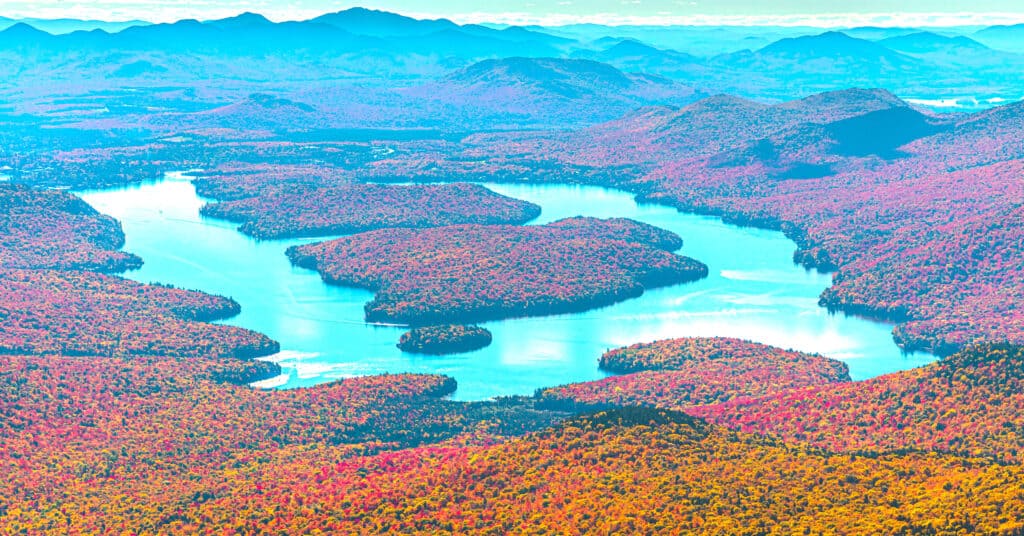
An aerial view of Lake Placid in New York surrounded by vibrant red foliage.
©iStock.com/Scott Ricks
Lake Placid has a maximum depth of 151 feet, making it an ideal environment for many different species of fish. Anglers can expect to find Rainbow trout, Lake trout, Smallmouth bass, Largemouth bass, Walleye, Brown trout, Perch, and Rock bass amongst many others in Lake Placid’s depths. Fishing is a popular pastime on the lake. New York State has had to set restrictions to three fish a day, with a 15-inch limit on catch size. The Ausable River is also nearby, which is a famous location for fly fishing.
Boating is another popular lake activity. There is a launching dock on Mirror Lake Drive to assist visitors with motorboats, paddle boats, canoes, kayaks, and sailboats. Many tourists enjoy kayaking around the lake. Beautiful views of the majestic Whiteface Mountain to the north, Mount Whitney to the east, and McKenzie Mountain to the west, it’s no surprise why.
Lake Placid is famous for twice hosting the Winter Olympic Games, once in 1932 and once in 1980. A large portion of the village’s infrastructure was created to meet the demands of hosting the Winter Olympics. That included ski jumps, bobsled paths, and even a skating rink.
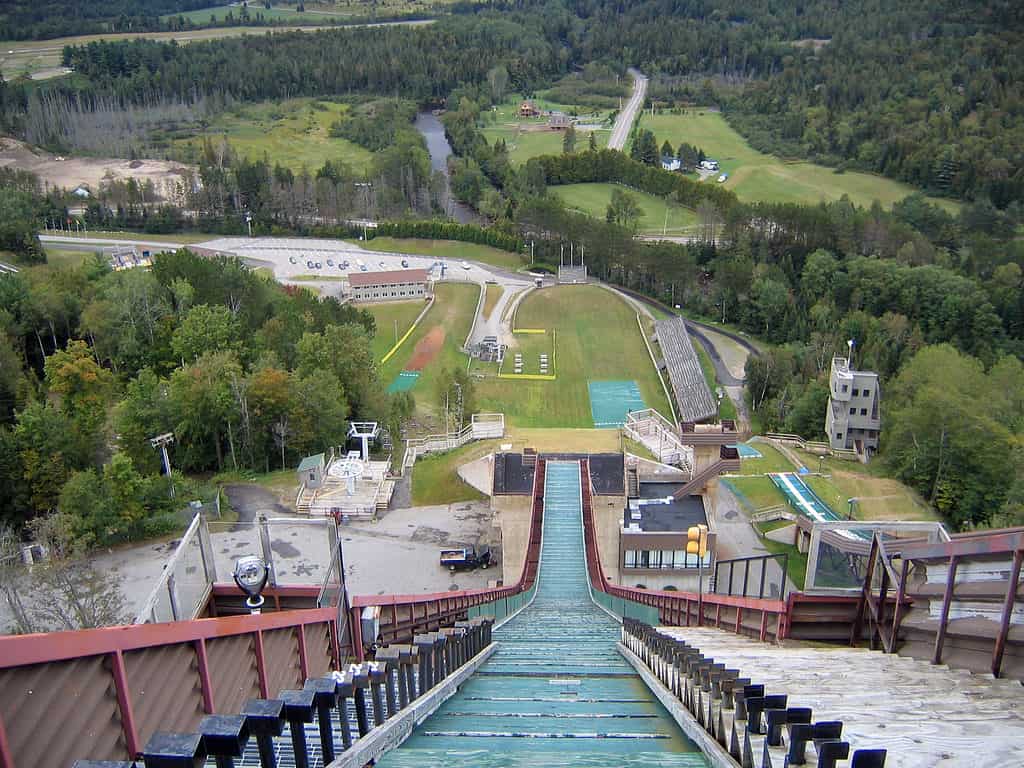
Lake Placid is famous for twice hosting the Winter Olympic Games.
©Artefficient/Shutterstock.com
Accordingly, skiing – both downhill skiing (Alpine) and cross-country skiing (Nordic) – is another common activity in Lake Placid. Whiteface Mountain is only 13 miles from town. In addition to gondola rides, bobsled runs, and excellent skiing courses in the winter, it also offers mountain biking and hiking options in the summertime. At 3,430 feet it is also one of the highest-elevation mountains in eastern America.
In 1898 one of the first golf courses in the country opens in Lake Placid. It provides more golfing options than any other place in the Adirondack Mountain Range. Famous architects such as Seymour Dunn, Alister MacKenzie, and John Van Kleek have all designed courses. They continue to draw in visitors from around the country and the world.
Otsego Lake
Otsego Lake, which comes from the Mohawk/Oneida word for “place of the rock.” It is a 4046-acre lake in Otsego County, New York. This is in reference to Council Rock, the impressive boulder on the south end of the lake which is now a small park. The Iroquois Indian tribes lived in the Susquehanna River Valley up until the end of the 1600s. A dam constructed in 1905 helps maintain the water level of the lake.
Forming ten thousand years ago by glaciers in the foothills of the Catskill Mountains is the naturally occurring Otsego Lake. The Susquehanna River flows from Otsego Lake. It provides drinking water for the Village of Cooperstown at the south end of the lake.
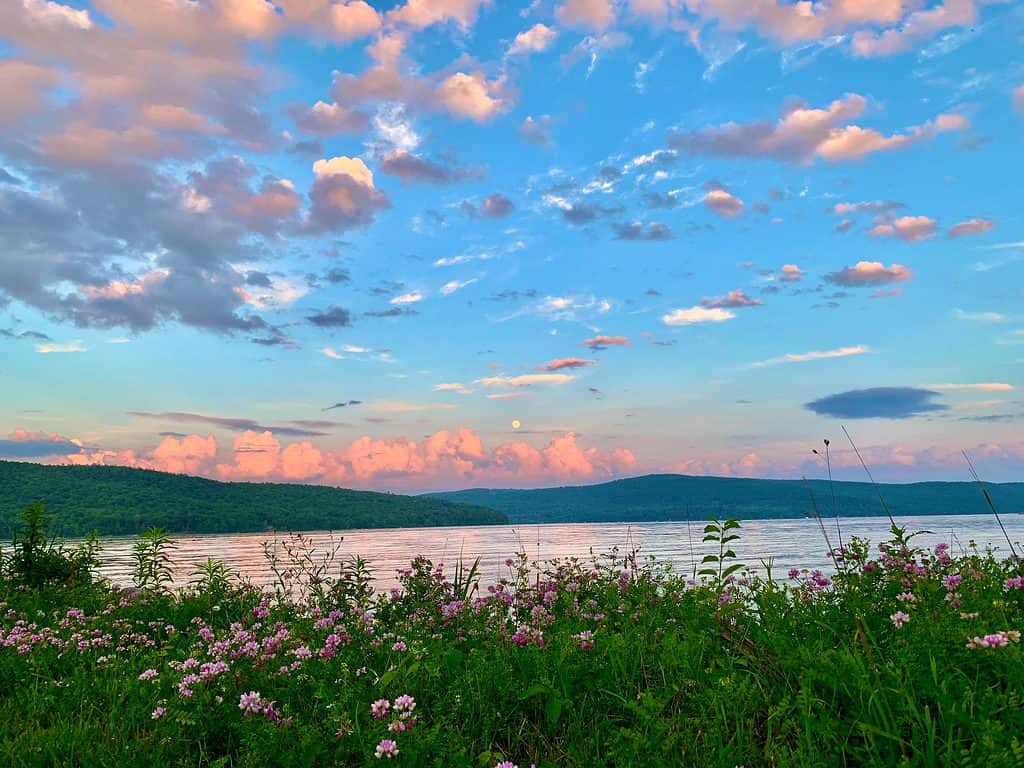
Otsego Lake is a naturally occurring lake, formed approximately ten thousand years ago by glaciers in the foothills of the Catskill Mountains.
©CoopersTiny/Shutterstock.com
Otsego Lake is the biggest lake in Otsego County. Visitors to the lake also enjoy sightseeing at Glimmerglass State Park on its northeastern shore. Hyde Hall, a mansion built in 1817, is a popular tourist attraction. Also of note is The Glimmerglass Opera (built in June of 1987) on the west shore.
Fishing is one of the most popular activities on Otsego Lake. Offering over forty different species of fish including Tessellated Darter, Largemouth and Smallmouth bass, Yellow and Brown Bullhead, Common, Blackchin, Spottail, and Spotfin Shiner as well as Bluntnose and Fathead Minnow and Yellow Perch.
With a shoreline length of 20 miles and a maximum depth of 167 feet, Otsego Lake is a great spot for kayaking, paddle boarding, swimming, canoeing, and fishing. The nearby village of Cooperstown is also famous for being the birthplace of baseball, America’s national pastime. This makes Otsego Lake a fascinating and entertaining place for anyone to visit.
Otsego Lake Conservation
Otsego Lake has also benefitted from several conservation efforts since the 1935 biological survey conducted by the New York State Conservation Department. Both the Otsego County Conservation Association (OCCA) and The Otsego Lake Association dedicate themselves to water potability efforts. The lake is also home to the +SUNY Biological Field Station. The State University of New York at Oneonta funds this research facility. It helps oversee the protection of Otsego Lake.
Great Sacandaga Lake
Great Sacandaga Lake is the largest man-made reservoir in New York, and also its best-kept secret. Tucked away in the woods of the Adirondacks, Great Sacandaga Lake is a 20,650-acre body of water. Boasting 41 miles of shoreline against a backdrop of forestry and mountaintops. The Adirondack Mountains provide a majestic setting for lakeside activities that range. Participate in anything from fishing, jet skiing, and boating to skiing, snowmobiling, camping, and good old-fashioned sunbathing.
Great Sacandaga Lake is a result of the artificial damming of the Sacandaga River in the Hudson Valley. This was part of an effort to maintain flood control and better direct the river’s flow. The construction of the Conklingville Dam began in 1927. It was finished by 1930 when they released 280 billion gallons of water into the valley to create Great Sacandaga. Its great size and depth (forty feet on average and sixty-five to ninety feet at maximum) make it the ideal habitat for a variety of fish species.
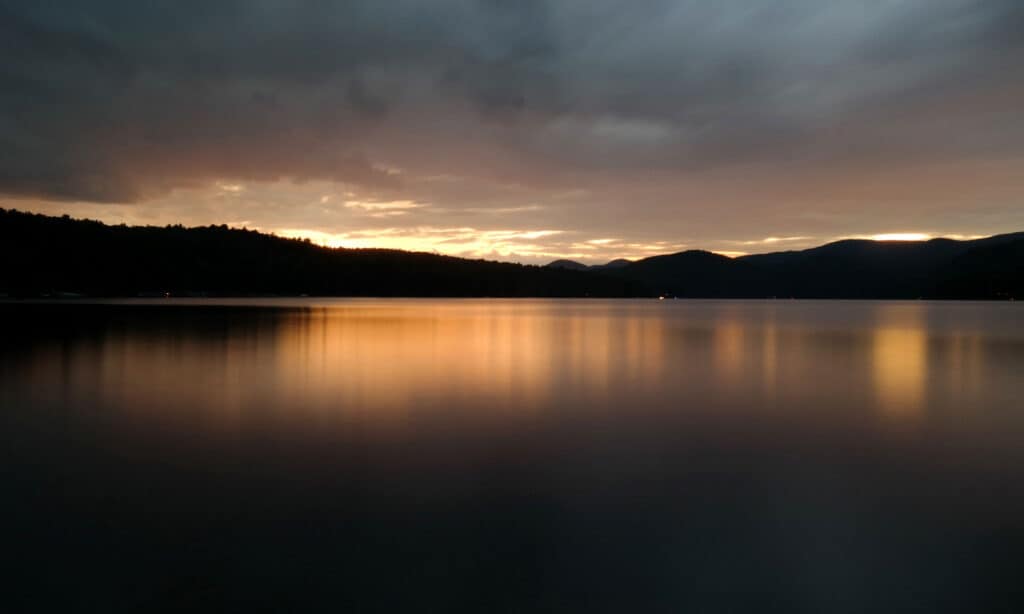
Tucked away in the woods of the Adirondacks, Great Sacandaga Lake is a 20,650-acre
body of water
.
©iStock.com/Christopher_Stepanian
Some of Great Sacandaga Lake’s most sought-after fish include Largemouth and Smallmouth Bass, Rainbow Trout, Brown Trout, Yellow Perch, Walleye, Channel Catfish, Rock Bass, Common Carp, and Black Crappie. The record pike for New York State was caught at this lake by Peter Dubuc on September 15th, 1940. It weighed a whopping forty-six pounds, two ounces. Ice fishing is a common substitute for fishing in the wintertime, making Great Sacandaga Lake an ideal location year-round.
Lake Huntington
Lake Huntington is a 100-acre lake in the Catskills mountain region of New York State. Located between the Delaware River and the Pennsylvania border. The Catskills are an often-visited section of the Appalachian Mountains. They are only one hundred miles away from New York City. Lake Huntington is fed by a series of springs. This makes it a beautiful location for escaping the business of the city.
Like many mountainside lakes in New York, Lake Huntington is a great spot for fishing. Though it has an average depth of 17 feet and a max depth of 35 feet, the lake is home to many species of fish including Largemouth Bass, Panfish, Chain Pickerel, Black Crappie, Walleye, and Rainbow Trout. They introduce 1,800 brown trout into the lake every spring, and ice-fishing is possible during the wintertime.
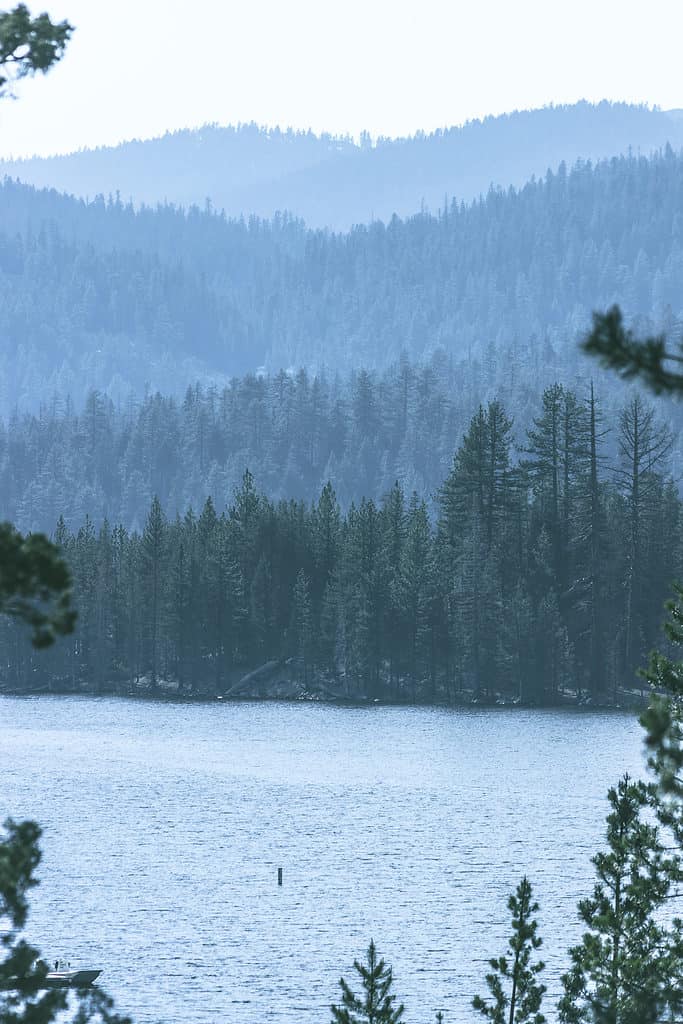
Lake Huntington is a 100-acre lake in the Catskills mountain region of New York State, located between the Delaware River and the Pennsylvania border.
©Kelvin T Mutize/Shutterstock.com
Other waterfront activities are possible at Lake Huntington, including kayaking, canoeing, snorkeling, and traversing the waters in an electric-powered boat. The small size of Lake Huntington means gas-powered boats are under restriction. This is to keep the water healthy and clear. The Nutshell Art Center is only a few minutes away from the lake. It is a great spot to relax and have a coffee while perusing their collection of local art.
Mirror Lake
Mirror Lake is a crystal-clear 128-acre lake near Lake Placid that beautifully reflects its serene surroundings. The neighboring Adirondack Mountains provide a blissful backdrop for those visiting Mirror Lake. Great views whether you’re swimming, fishing, or taking part in the host of lakeside activities available to you.
While the size of the lake prevents motorboating, there are plenty of canoes, kayaks, electric-powered boats, sailboats, and paddle boats available for use. Aquabikes are another fun option for traversing Mirror Lake.
If walking is more your style, you can circle the entire lake. In only 2.7 miles, you can make the “Central Park” loop trail. A playground and a series of tennis courts also make for a fun stay with the family.

Fishing is a popular activity on Mirror Lake.
©iStock.com/Frank DeBonis
During the summertime, a free weekly music series “Songs at Mirror Lake” is in Mid’s Park right on the lake shore. This means you can listen to wonderful songs from the comfort of your beach chair or even your stand-up paddleboard!
Fishing is a popular activity on Mirror Lake. There is nearly three miles of shoreline. It also offers a variety of species including Pumpkinseed, Brown Bullhead, Lake Trout, Rainbow Trout, Rock Bass, Yellow Perch, and Smallmouth Bass.
As the winter months arrive and swimming becomes a less appealing concept, many visitors take to skiing, ice skating, and even dog sledding. There is also a toboggan chute for adventurous-minded tourists.
Summary Of The 8 Most Beautiful Mountain Lakes In New York
| Rank | Lake | Location |
|---|---|---|
| 1 | Lake George | Lake George |
| 2 | Lake Champlain | between the Green Mountains of Vermont and the Adirondack Mountains of New York |
| 3 | Avalanche Lake | near Lake Placid, Adirondacks |
| 4 | Lake Placid | Lake Placid, Adirondacks |
| 5 | Otsego Lake | Cooperstown, in the foothills of the Catskill Mountains |
| 6 | Great Sacandaga Lake | Fulton and Saratoga counties, in the Adirondacks |
| 7 | Lake Huntington | Cochecton in Sullivan County |
| 8 | Mirror Lake | Lake Placid, Adirondacks |
The photo featured at the top of this post is © iStock.com/KvitkaNastroyu
FAQs (Frequently Asked Questions)
What is the most well-known lake in New York State?
Deep in the northeastern reaches of the Adirondack Mountain range lies Lake George, a small town with a lake by the same name. As one of the most famous lakes in New York State, Lake George is the “Queen of American Lakes.” This body of water stretches over 28,160 acres, with 109 miles of shoreline perfect for fishing, boating, or relaxing at the water’s edge.
Which town has hosted the Winter Olympics twice?
Lake Placid is famous for twice hosting the Winter Olympic Games, once in 1932 and once in 1980. A large portion of the village’s infrastructure was created to meet the demands of hosting the Winter Olympics. That included ski jumps, bobsled paths, and even a skating rink.
Thank you for reading! Have some feedback for us? Contact the AZ Animals editorial team.






